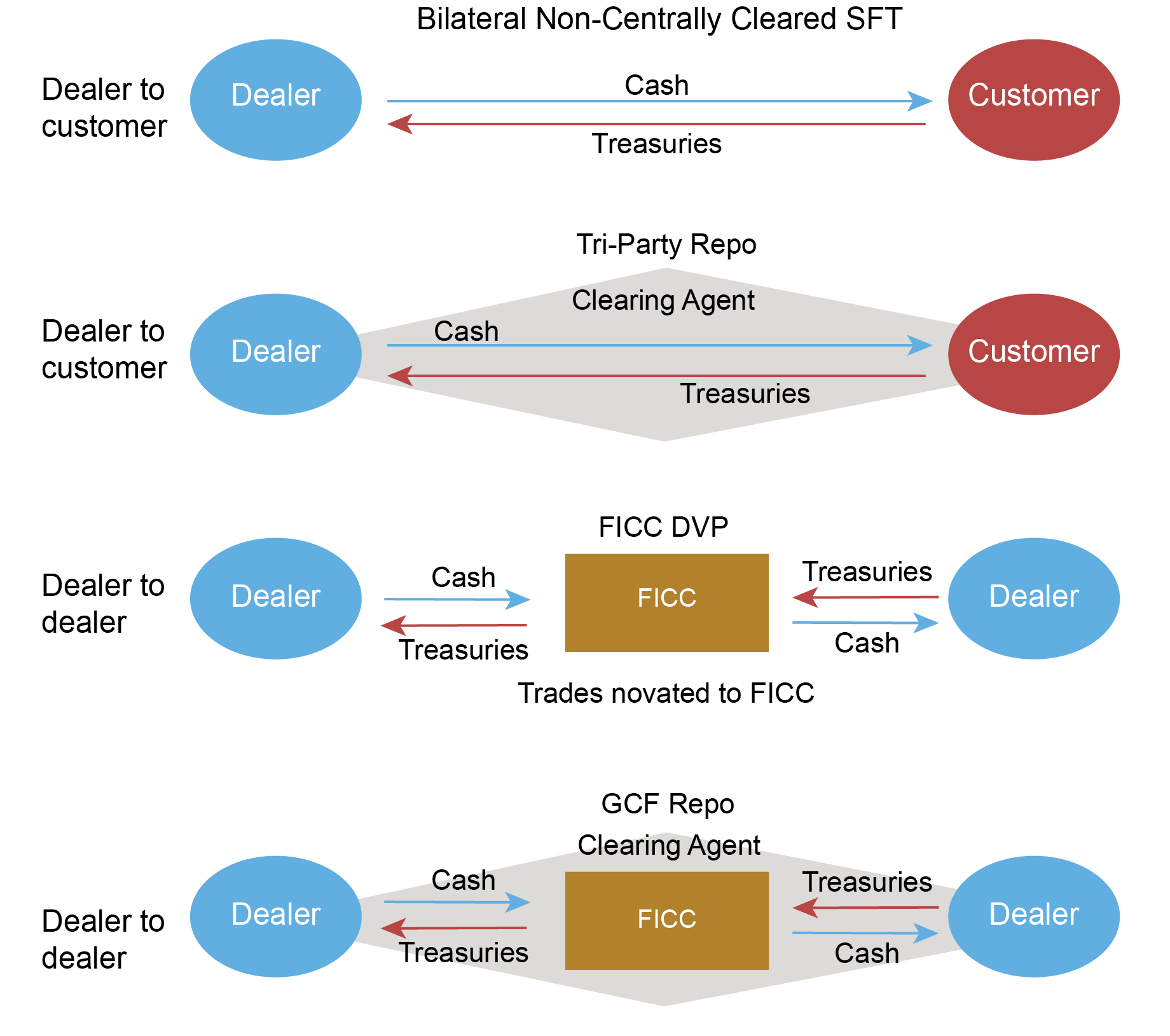
The New York Fed’s Treasury Market Practices Group (TMPG) lately launched a consultative white paper on clearing and settlement processes for secured financing trades (SFT) involving U.S. Treasury securities. The paper describes the various ways in which Treasury SFTs are cleared and settled— info that will not be available to all market contributors. It additionally identifies potential danger and resiliency points, and so promotes dialogue about whether or not present practices have room for enchancment. This work is well timed given the SEC’s ongoing efforts to enhance transparency and decrease systemic danger within the Treasury market by growing the prevalence of central clearing. On this publish, we summarize the present state of clearing and settlement for Treasury SFTs and spotlight a number of the key dangers described within the white paper.
The Marketplace for Treasury Secured Financing Transactions
Treasury SFTs—together with repurchase agreements (repos) and securities lending—are a part of the collateralized U.S. dollar-denominated cash markets. Treasury repos are monetary transactions wherein a celebration sells U.S. Treasury securities to a different celebration with a promise to repurchase the asset at a pre-specified value and date. Treasury securities lending is the short-term mortgage of U.S. Treasury securities in alternate for money or different collateral. Securities lending towards money and repo agreements are economically related, and buyers and companies use repo and securities lending to safe funding for his or her actions, make markets, and facilitate the implementation of assorted funding, danger administration, and collateral administration actions.
How Do Treasury SFT Trades Clear and Settle?
There are two massive segments of the Treasury SFT market: dealer-to-customer and dealer-to-dealer. Most dealer-to-customer trades are cleared and settled in one in all two methods. The primary is on a bilateral foundation, when every celebration to the commerce makes use of its personal bespoke clearing and settlement processes. The second leverages the tri-party settlement platform provided by a clearing financial institution; underneath this agent-cleared strategy, each events to the commerce use the processes provided by the clearing financial institution.
A 3rd, much less frequent clearing choice for dealer-to-customer trades is to make the most of the Sponsored Service supplied by the only real central counterparty (CCP) within the Treasury market, the Mounted Revenue Clearing Company. Trades which can be centrally cleared by means of the Sponsored Service are both settled on the tri-party repo settlement platform or on a bilateral foundation, relying on the character of the commerce.
In distinction to the dealer-to-customer phase, most dealer-to-dealer trades are cleared by means of the CCP utilizing both its Common Collateral Finance (GCF®) Repo Service or Supply-Versus-Cost (DVP) Service. Trades cleared utilizing the GCF Repo Service are settled on the tri-party settlement platform, whereas for trades cleared utilizing the DVP Service, every market participant makes use of its respective settlement processes.
The exhibit under summarizes the 4 fundamental ways in which SFTs clear and settle.
Trades in Treasury SFT Markets

Danger and Resiliency Points
Do market contributors absolutely perceive the dangers related to the various clearing and settlement strategies obtainable for SFTs? The white paper discusses a number of issues on which the TMPG hopes to obtain suggestions. Right here we spotlight two: (i) Total, the clearing and settlement of SFTs is fragmented and (ii) for non-centrally cleared bilateral SFTs, clearing and settlement is bespoke and opaque.
The primary danger displays the very fact the clearing and settlement ecosphere for SFTs has organically grown over time to satisfy the assorted wants of various market contributors. Because of this, there are actually a large number of clearing and settlement choices obtainable. For a given choice, dangers to a clean post-trade course of for Treasury SFTs can manifest in a number of methods, together with counterparty credit score issues and operational points. The big variety of clearing and settlement choices—this fragmentation in post-trade providers—locations a major burden on market contributors to completely acknowledge the inherent dangers of every choice, and to place the suitable danger mitigants into place.
In regular occasions, when a counterparty’s danger of default is idiosyncratic and Treasury market liquidity is deep, the variations in clearing and settlement processes have solely small implications for danger. In occasions of stress, nonetheless, when defaults are extra frequent and general Treasury market liquidity can lower, these variations might have essential danger implications.
The second danger focuses on SFTs, that are neither centrally cleared nor settled on a tri-party settlement platform. For these non-centrally cleared bilateral SFTs, market contributors rely on individualized clearing and settlement preparations. These may go effectively in the course of the bizarre course of enterprise, however the bespoke nature of those preparations, mixed with the brief time period between commerce execution and commerce settlement, could make resolving post-trade disputes a difficult activity. Certainly, in occasions of stress, disputes sometimes come up extra regularly and could also be tougher to resolve in a well timed method, growing the chance of a disruption to settlement, which might in flip create surprising credit score exposures.
Provided that the clearing and settlement dangers related to Treasury SFTs are pretty benign in the course of the regular course of enterprise, some market contributors could not absolutely use the array of danger administration instruments to mitigate these dangers. The opaqueness of those processes obscures a participant’s means to evaluate the counterparty credit score danger a participant incurs not directly by means of the clearing chain. The place transparency is impaired, market contributors could not have the ability to precisely establish, measure, and handle their counterparty danger publicity. This opaqueness might then create an undesirable stage of mixture danger within the Treasury SFT market.
Subsequent Steps
The TMPG awaits extra public suggestions on the white paper. Primarily based on that suggestions, the TMPG expects to finalize the white paper and should present additional voluntary steerage on clearing and settlement finest practices.

Adam Copeland is a monetary analysis advisor in Cash and Funds Research within the Federal Reserve Financial institution of New York’s Analysis and Statistics Group.

Frank Keane is a coverage and market-monitoring advisor within the Federal Reserve Financial institution of New York’s Markets Group.

Jenny Phan is a capital markets buying and selling principal within the Federal Reserve Financial institution of New York’s Markets Group.
Find out how to cite this publish:
Adam Copeland, Frank Keane, and Jenny Phan, “Are There Too Many Methods to Clear and Settle Secured Financing Transactions?,” Federal Reserve Financial institution of New York Liberty Road Economics, Could 8, 2023, https://libertystreeteconomics.newyorkfed.org/2023/05/are-there-too-many-ways-to-clear-and-settle-secured-financing-transactions/.
Disclaimer
The views expressed on this publish are these of the writer(s) and don’t essentially replicate the place of the Federal Reserve Financial institution of New York or the Federal Reserve System. Any errors or omissions are the duty of the writer(s).

